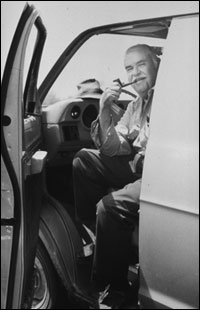Joe Ben Wheat Biography: Who Was Joe Ben Wheat?
 |
Joe Ben Wheat, 1981. |
Joe Ben Wheat was born and raised in the small West Texas town of Van Horn, where he first became interested in archaeology through exploring the local countryside. He received his BA in 1937 from the University of California, Berkeley, and after serving in the Second World War, he earned a Ph.D. in Anthropology from the University of Arizona. Shortly after his graduation in 1953, he was hired as the first Curator of Anthropology by the University of Colorado Museum, a position he held for the remainder of his career.
As a young archaeologist Wheat had worked for the Smithsonian River Basin Surveys, where he became familiar with the Smithsonian nomenclature for archaeological site numbering. This system assigns a separate number for each state, a two letter abbreviation for each county in a state, and a sequentially assigned site number (e.g., 5MT1, where 5 represents Colorado, MT is Montezuma County, and 1 corresponds to the first site recorded in that county). He applied this system in Colorado during his first seasons at Yellow Jacket, and later was instrumental in the adoption of the system as the standard throughout the state.
Wheat's early work also included excavations at Point of Pines and Crooked Ridge Village during his time at the University of Arizona. His dissertation, based on his work at Crooked Ridge Village, was the basis for two publications (Wheat 1954Wheat, Joe Ben
1954 Crooked Ridge Valley (Arizona W:10:15). University of Arizona Social Science Bulletin 24. Tucson., 1955bWheat, Joe Ben
1955b Mogollon Culture Prior to AD 1000. Memoirs of the Society for American Archaeology 10. Memoirs of the American Anthropological Association 82.), which have become standards in Mogollon archaeology. Wheat's interest in the pithouse occupations in Arizona led directly to his work at Yellow Jacket in the Anasazi region, where he began by excavating an early pithouse occupation at Site 5MT1.
Wheat's work at three sites at Yellow Jacket spanned from 1954 until 1991, with only a few interruptions. During 1958 and 1960, he excavated at the Olsen-Chubbuck site, an important PaleoIndian kill site in southeastern Colorado (Wheat 1972Wheat, Joe Ben
1972 The Olsen-Chubbuck Site: A Paleo-Indian Bison Kill. Society for American Archaeology Memoir 26. Washington, D.C.). In 1968 and 1970 he investigated another PaleoIndian site, the Jurgens site in northeastern Colorado (Wheat 1979Wheat, Joe Ben
1979 The Jurgens Site. Plains Anthropologist Memoir 15. Lincoln, Nebraska.). He also took part in the University's Paleolithic and Mesolithic research expeditions to Sudan and Tunisia in 1962, 1963, and 1966. Finally, in 1972 he took a sabbatical to conduct research on Southwest textiles, the beginning of a seminal work that resulted in a posthumous publication (Wheat 2003Wheat, Joe Ben
2003 Blanket Weaving in the Southwest. Edited by Ann L. Hedlund. University of Arizona Press, Tucson.).
Although Wheat was a consummate scholar, recognized internationally for his contributions to PaleoIndian and Southwestern archaeology and to textile studies, he considered one of his most important roles to be that of teacher and mentor. The field school at Yellow Jacket was an important part of his life for this reason as much as for the archaeology done there. During the 1960s and 1970s, when women still were not readily accepted into archaeological field schools, Wheat often had predominantly female crews and crew chiefs, giving opportunities to many whom would not have had them otherwise. He served on numerous graduate committees, worked with student interns in the museum, and remained accessible to his students, even after his retirement in 1986.
To the end, he provided funding to ensure that student research continued on the Yellow Jacket collections, a contribution that his widow Barbara Wheat carries on today. Joe Ben Wheat passed away in 1997, at the age of 81. His ashes were scattered close to the site he began excavating with Hod Stevenson five decades before.
